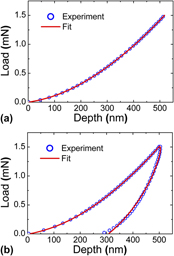Crossref Citations
This article has been cited by the following publications. This list is generated based on data provided by
Crossref.
Peng, Guangjian
Feng, Yihui
Huan, Yong
and
Zhang, Taihua
2013.
Characterization of the viscoelastic-plastic properties of UPVC by instrumented sharp indentation.
Polymer Testing,
Vol. 32,
Issue. 8,
p.
1358.
Peng, Guangjian
Feng, Yihui
Wen, Donghui
and
Zhang, Taihua
2014.
An instrumented indentation method for evaluating the effect of hydrostatic pressure on the yield strength of solid polymers.
Journal of Materials Research,
Vol. 29,
Issue. 24,
p.
2973.
Peng, Guangjian
Ma, Yi
Feng, Yihui
Huan, Yong
Qin, Chunjie
and
Zhang, Taihua
2015.
Nanoindentation creep of nonlinear viscoelastic polypropylene.
Polymer Testing,
Vol. 43,
Issue. ,
p.
38.
Tan, Xiaohua
Qiu, Wei
Kang, Yilan
Fu, Donghui
Li, Xiaolei
and
Xiao, Xia
2015.
Experimental analysis on soft material contact problems by digital moiré and embedded-grating methods.
Acta Mechanica Solida Sinica,
Vol. 28,
Issue. 3,
p.
252.
McKenna, Gregory
and
Zhai, Meiyu
2016.
Polymer Glasses.
p.
205.
Ma, Y.
Peng, G.J.
Chen, H.
Jiang, W.F.
and
Zhang, T.H.
2018.
On the nanoindentation hardness of Cu-Zr-Al/Cu nanolaminates.
Journal of Non-Crystalline Solids,
Vol. 482,
Issue. ,
p.
208.
Chen, J.F.
Xu, K.J.
Tang, L.Q.
Liu, Z.J.
and
Zhou, L.C.
2018.
Study on the optimal loading rates in the measurement of viscoelastic properties of hydrogels by conical indentation.
Mechanics of Materials,
Vol. 119,
Issue. ,
p.
42.
Li, Yuanxin
Zhang, Jianwei
Zhang, Yunlong
Zhao, Minghao
Lu, Chunsheng
and
Liu, Ming
2025.
A semi-analytical solution for determining plastic parameters of metallic materials from scratch tests.
International Journal of Solids and Structures,
Vol. 310,
Issue. ,
p.
113226.
